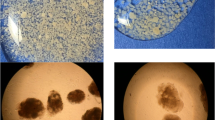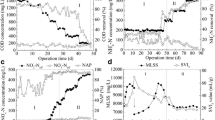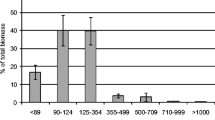Abstract
The survival of the inoculated microbial culture is critical for successful bioaugmentation but impossible to predict precisely. As an alternative strategy, bioaugmentation of a group of microorganisms may improve reliability of bioaugmentation. This study evaluated simultaneous bioaugmentation of two functionally similar bacterial strains in aerobic granules. The two strains, Pandoraea sp. PG-01 and Rhodococcus erythropolis PG-03, showed high phenol degradation and growth rates in phenol medium, but they were characterized as having a poor aggregation activity and weak bioflocculant-producing and biofilm-forming abilities. In the spatially homogeneous batch conditions, strain PG-01 with higher growth rates outcompeted strain PG-03. However, the two strains could stably coexist in the spatially heterogeneous conditions. Then the two strains were mixed and bioaugmented into activated sludge in two sequencing batch reactors, which were operated with the different settling times of 5 and 30 min, respectively. Aerobic granules were developed only in the reactor with a settling time of 5 min. Fluorescence in situ hybridization and denaturing gradient gel electrophoresis showed that the two strains could coexist in aerobic granules but not in activated sludge. These findings suggested that the compact structure of aerobic granules provided spatial isolation for coexistence of competitively superior and inferior strains with similar functions.





Similar content being viewed by others
References
Abed RMM, Safi NMD, Koster J, de Beer D, El-Nahhal Y, Rullkotter J, Garcia-Pichel F (2002) Microbial diversity of a heavily polluted microbial mat and its community changes following degradation of petroleum compounds. Appl Environ Microbiol 68:1674–1683
Alm EW, Oerther DB, Larsen N, Stahl DA, Raskin L (1996) The oligonucleotide probe database. Appl Environ Microbiol 62:3557–3559
American Public Health Association (APHA) (1998) Standard methods for the examination of water and wastewater, APHA, Washington, DC
Ayala-del-Rio HL, Callister SJ, Criddle CS, Tiedje JM (2004) Correspondence between community structure and function during succession in phenol-and phenol-plus-trichloroethene-fed sequencing batch reactors. Appl Environ Microbiol 70:4950–4960
Beun JJ, Hendriks A, van Loosdrecht MCM, Morgenroth E, Wilderer PA, Heijnen JJ (1999) Aerobic granulation in a sequencing batch reactor. Water Res 33:2283–2290
Boon N, de Gelder L, Lievens H, Siciliano SD, Top EM, Verstraete W (2002) Bioaugmenting bioreactors for the continuous removal of 3-chloroaniline by a slow release approach. Environ Sci Technol 36:4698–4704
Bouchez T, Patureau D, Dabert P, Juretschko S, Dore J, Delgenes P, Moletta R, Wagner M (2000) Ecological study of a bioaugmentation failure. Environ Microbiol 2:179–190
Bruns MA, Hanson JR, Mefford J, Scow KM (2001) Isolate PM1 populations are dominant and novel methyl tert-butyl ether-degrading bacteria in compost biofilter enrichments. Environ Microbiol 3:220–225
Chen JQ, Weimer PJ (2001) Competition among three predominant ruminal cellulolytic bacteria in the absence or presence of non-cellulolytic bacteria. Microbiology 147:21–30
Davenport RJ, Curtis TP, Goodfellow M, Stainsby FM, Bingley M (2000) Quantitative use of fluorescent in situ hybridization to examine relationships between mycolic acid-containing actinomycetes and foaming in activated sludge plants. Appl Environ Microbiol 66:1158–1166
Ellis RJ, Thompson IP, Bailey MJ (1999) Temporal fluctuations in the pseudomonad population associated with sugar beet leaves. FEMS Microbiol Ecol 28:345–356
Fernandez A, Huang SY, Seston S, Xing J, Hickey R, Criddle C, Tiedje J (1999) How stable is stable? Function versus community composition. Appl Environ Microbiol 65:3697–3704
Fernandez AS, Hashsham SA, Dollhopf SL, Raskin L, Glagoleva O, Dazzo FB, Hickey RF, Criddle CS, Tiedje JM (2000) Flexible community structure correlates with stable community function in methanogenic bioreactor communities perturbed by glucose. Appl Environ Microbiol 66:4058–4067
Jiang HL, Tay JH, Tay STL (2002) Aggregation of immobilized activated sludge cells into aerobically grown microbial granules for the aerobic biodegradation of phenol. Lett Appl Microbiol 35:439–445
Jiang HL, Tay JH, Tay STL (2004a) Changes in structure, activity and metabolism of aerobic granules as a microbial response to high phenol loading. Appl Microbiol Biotechnol 63:602–608
Jiang HL, Tay JH, Maszenan AM, Tay STL (2004b) Bacterial diversity and function of aerobic granules engineered in a sequencing batch reactor for phenol degradation. Appl Environ Microbiol 70:6767–6775
Jiang HL, Tay JH, Maszenan AM, Tay STL (2006) Physiological traits of bacterial strains isolated from phenol-degrading aerobic granules. FEMS Microbiol Ecol 57:182–191
Kurane R, Hatamochi K, Kakuno T, Kiyohara M, Kawaguchi K, Mizuno Y, Hirano M, Tamihuchi Y (1994) Purification and characterization of lipid bioflocculant produced by Rhodococcus erythropolis. Biosci Biotechnol Biochem 58:1977–1982
Liu Y, Tay JH (2004) State of the art of biogranulation technology for wastewater treatment. Biotechnol Advances 22:533–563
Loreau M, Naeem S, Inchausti P, Bengtsson J, Grime JP, Hector A, Hooper DU, Huston MA, Raffaelli D, Schmid B, Tilman D, Wardle DA (2001) Biodiversity and ecosystem functioning: current knowledge and future challenges. Science 294:804–808
Maidak BL, Cole JR, Lilburn TG, Parker CT, Saxman PR, Farris RJ, Garrity GM, Olsen GJ, Schmidt TM, Tiedje JM (2001) The RDP-II (Ribosomal Database Project). Nucleic Acids Res 29:173–174
Morgenroth E, Sherden T, van Loosdrecht MCM, Heijnen JJ, Wilderer PA (1997) Aerobic granular sludge in a sequencing batch reactor. Water Res 31:3191–3194
Muyzer G, Dewaal EC, Uitterlinden AG (1993) Profiling of complex microbial-populations by denaturing gradient gel-electrophoresis analysis of polymerase chain reaction-amplified genes-coding for 16S ribosomal-RNA. Appl Environ Microbiol 59:695–700
Naeem S, Li SB (1997) Biodiversity enhances ecosystem reliability. Nature 390:507–509
Norberg J, Swaney DP, Dushoff J, Lin J, Casagrandi R, Levin SA (2001) Phenotypic diversity and ecosystem functioning in changing environments: a theoretical framework. Proc Natl Acad Sci USA 98:11376–11381
O’Toole GA, Kolter R (1998) Initiation of biofilm formation in Pseudomonas fluorescens WCS365 proceeds via multiple, convergent signalling pathways: a genetic analysis. Mol Microbiol 28:449–461
Rainey PB, Travisano M (1998) Adaptive radiation in a heterogeneous environment. Nature 394:69–72
Rosenberg M, Gutnick D, Rosenberg E (1980) Adherence of bacteria to hydrocarbons: a simple method from measuring cell-surface hydrophobicity. FEMS Microbiol Lett 9:29–33
Tay STL, Moy BYP, Maszenan AM, Tay JH (2005) Comparing activated sludge and aerobic granules as microbial inocula for phenol biodegradation. Appl Microbiol Biotechnol 115:387–395
Thompson IP, van der Gast CJ, Ciric L, Singer AC (2005) Bioaugmentation for bioremediation: the challenge of strain selection. Environ Microbiol 7:909–915
Treves DS, Xia B, Zhou J, Tiedje JM (2003) A two-species test of the hypothesis that spatial isolation influences microbial diversity in soil. Microb Ecol 45:20–28
van der Gast CJ, Whiteley AS, Thompson IP (2004) Temporal dynamics and degradation activity of an bacterial inoculum for treating waste metal-working fluid. Environ Microbiol 6:254–263
vanVeen JA, vanOverbeek LS, vanElsas JD (1997) Fate and activity of microorganisms introduced into soil. Microbiol Mol Biol Rev 61:121–135
von Canstein H, Kelly S, Li Y, Wagner-Dobler I (2002) Species diversity improves the efficiency of mercury-reducing biofilms under changing environmental conditions. Appl Environ Microbiol 68:2829–2837
Walker B, Kinzig A, Langridge J (1999) Plant attribute diversity, resilience, and ecosystem function: the nature and significance of dominant and minor species. Ecosystems 2:95–113
Zhou JZ, Xia BC, Treves DS, Wu LY, Marsh TL, O’Neill RV, Palumbo AV, Tiedje JM (2002) Spatial and resource factors influencing high microbial diversity in soil. Appl Environ Microbiol 68:326–334
Acknowledgments
H.L.J. thanks Singapore Millennium Foundation for financial support.
Author information
Authors and Affiliations
Corresponding author
Rights and permissions
About this article
Cite this article
Jiang, HL., Maszenan, A.M. & Tay, JH. Bioaugmentation and coexistence of two functionally similar bacterial strains in aerobic granules. Appl Microbiol Biotechnol 75, 1191–1200 (2007). https://doi.org/10.1007/s00253-007-0917-9
Received:
Revised:
Accepted:
Published:
Issue Date:
DOI: https://doi.org/10.1007/s00253-007-0917-9




